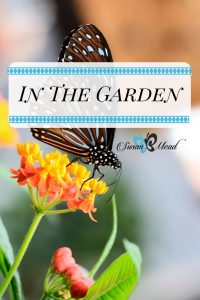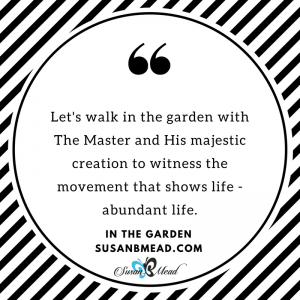The Garden. Life started in the Garden…
29 Then God said, “I give you every seed-bearing plant on the face of the whole earth and every tree that has fruit with seed in it. They will be yours for food.
30 And to all the beasts of the earth and all the birds in the sky and all the creatures that move along the ground—everything that has the breath of life in it—I give every green plant for food.”
And it was so.
31 God saw all that he had made, and it was very good. And there was evening, and there was morning—the sixth day.
Genesis 1:29-31(NIV)
God created life in the garden. Motion and movement create life in your garden, inviting you – and a host of lovely things that flutter and dart about – into your own yard.
Do you desire an area that attracts butterflies and birds? Then plant plants that are inviting to the wildlife you yearn to see – remember, God made the plants for food for us and for His critters. So feed them and know it’s your way of sending them an inscribed invitation…

The hummingbird hovers then flits away as the butterfly lazily lolls about, looping from flower to flower, creating movement in your yard. You’re engaged as you dash to the door to see who whizzed by. You wonder, what is that bird with the red bib and white crest? It’s a ruby-throated grosbeak migrating north – and it came to visit you!
A hummingbird darts by. Does that delight you? Plant flowers that hold nectar, as they are the best for hummingbirds. Hummers lick up the nectar in these flowers – and oh how fast they do! I thought they sucked up the nectar like sipping through a straw, yet that is not how they eat after all – they lick up the nectar like a puppy licks water.
Plant a pop of bold red flowers. Their blooms are a personalized invitation to the hummingbirds to come dine with you. Many brightly colored flowers also invite the little hummers over for dinner.
Tubular shaped flowers hold the most nectar so are the best choices for hummers. These include wonderful perennials such as bee balm (Mondarda), columbine (Aquilegia), and daylily (Hemerocallis); biennials such as foxglove (Digitalis) and hollyhock (Alcea rosea); and many annuals, including petunias (Petunia), impatiens (Impatiens) and cleomes (Cleome).
Butterflies add such beauty and intrigue to the garden as you search for what stopped by to visit. You simply need to know their name!
Plant for both the adults and the caterpillars to get the entire life cycle. FYI – please put up the pesticides, as pesticides kill the butterflies and the caterpillars that hatch into the beauties you invited.
Here’s the general rule: adult butterflies “drink” from nectar plants and caterpillars eat host plants – so plant lots of host plants, as they disappear quickly when the caterpillars start munching away. Some caterpillars eat very specific plants, so search online for the preferred plant(s) of any particular butterfly.
Flowers that attract many butterflies include lantana (Lantana), butterfly bush (Buddleia), Mexican sunflowers (Tithonia), zinnia (Zinnia), pentas (Pentas), purple coneflowers (Echinacea) and milkweed (Asclepias).
Milkweed does double duty as a host plant for Monarchs. Make room for these plants each year to be rewarded with lots of movement and life in your garden!
Host plants for the caterpillars include herbs such as parsley (Petroselinum crispum), common rue (Ruta graveolens), dill (Anethum graveolens), fennel (Foeniculum vulgare), as well as tropical milkweed (Asclepias curassavica), violets (Viola odorata), carrots (Daucus carota), and passionflowers (Passiflora incarnata and Passiflora caerulea). Many trees and bushes also serve as host plants for caterpillars.
Plants that attract summer birds include Monarda, black-eyed Susan (Rudbeckia), blanket flower (Gaillardia), coralbells (Heuchera), coreopsis (Coreopsis), cosmos (Cosmos), flowering tobacco (Nicotiana), liatris (Liatris), Echinacea, marigolds (Calendula), Zinnia, Asters, poppies (Papaver) and sunflowers (Helianthus).
The honeybee population has been on the decline in recent years. Do you want to plant a little slice of heaven on earth for these vitally important pollinators? How beneficial it is for each one of us to help rebuild the bee colonies.
Plants that bees feast on include borage (Borago officinalis), Calendula, Crocus, hyacinth (Hyacinthus), in the spring; Monarda, Cosmos, Echinacea, snapdragons (Antirrhinum), Digitalis, and hosta (Funkia) in the summer; and Zinnia, Sedum, asters (Asteraceae), witch hazel (Hamamelis) and goldenrod (Solidago) in the fall.
So plant and let your beautiful flowers invite the friendly little foragers to frolic in your front yard!
I recently completed certification as a Master Gardener – something I wanted to do for 20 years. Anticipate a few “In the Garden” articles in the future.
Remember, in the garden of Eden is where God created His first human son, Adam, and in the Garden of Gethsemane is where His Divine Son, Jesus, sweated blood as the weight of the world pressed on Him prior to His death. And when the garden of Eden is restored, the tree of life grows…
Let’s walk in the garden, with The Master and His majestic creation. Let’s witness the movement that shows life – abundant life.

Eden Restored
22 Then the angel showed me the river of the water of life, as clear as crystal, flowing from the throne of God and of the Lamb 2 down the middle of the great street of the city. On each side of the river stood the tree of life, bearing twelve crops of fruit, yielding its fruit every month. And the leaves of the tree are for the healing of the nations. 3 No longer will there be any curse. The throne of God and of the Lamb will be in the city, and his servants will serve him. 4 They will see his face, and his name will be on their foreheads. 5 There will be no more night. They will not need the light of a lamp or the light of the sun, for the Lord God will give them light. And they will reign for ever and ever.
Revelation 22:1-5 (NIV)
[Tweet “DanceWithJesus in the garden today!”]
[inlinkz_linkup id=712043 mode=1]

Thanks for linking up with #TuneInThursday this past week.
I don’t have a garden. I can’t seem to keep living things alive (other than my children and my dog!). Your garden sounds wonderful.
It is becoming a beauty yet we are just a few months into this new home so LOTS to do, Barbie. Hugs, Susan
walk in the garden with a grateful heart..
Amen Indah! And thank you, gratefully, hugs, Susan
To sit in my garden, under the large Pecan tree, listening to the variety of birds chirping and singing, while reading God’s Word, is a day of completeness for me! I am visiting you today from the Rich Faith Rising link up
Jennifer,
Rich Faith Rising – what a lovely scenario you painted for me of sitting under the pecan tree in your garden listening to the glory of God’s birds and reading. OH JOY!
Hugs, Susan
I’m afraid you’ve just made me jealous? All those things in a garden? I have dry earth, lumpy grass and not much else in my yard right now. Ah, but I’m not done yet! There’s hope! Flowers and butterflies, we’re coming!
Oh Carol! Yes there is HOPE for your garden! Hugs, Susan
The garden is one of my most favorite spaces!
The garden is such a delightful place to be, I agree Crystal. Dirty fingernails and all… Hugs, Susan
The garden is a wonderful place…. and a great place to talk w/ the Lord as I admire the beauty and creativity of what He has made. 🙂
Yes, the garden is a treasure straight from God for us to admire His creativity and beauty. Hugs, Susan
My eight year old granddaughter has been asking lots of questions about life in the garden and the fall of man. It’s been a good journey for me to revisit some of these things as I have conversations with her.
Oh Elizabeth, our best teachers are our students who demand we know more than they know so we can instruct them…How powerful to have a granddaughter coming to you with questions that stretch and grow you – or simply help you remember what you already know! Hugs, Susan
Susan- perfect timing as we have plans to landscape our back yard. I would love to attract all these creatures so my family can enjoy them:)
Congrats on the master gardener completion! Sounds fun:)
I hope this article was helpful in your plant selection Julie! Hugs, Susan
Amen! I want to pay more attention to what’s in the garden…the beauty and goodness of the world.
Yes, Tara, I agree, paying attention allows us to see His beauty and goodness. Hugs, Susan
I’ve been planting lots of flowers this past week so hopefully I’ll see lots of insects and birds over the summer. Thanks for sharing this encouragement, Susan!
Oh, send pictures when they start blooming Lisa! I LOVE seeing our labor rewarded. Hugs, Susan
Congratulations, Susan! I love butterflies. My sister in love has a beautiful garden with the right plants in place, and we sit by the window and spend lots of time ooh-ing and aah-ing over their grace and beauty.
Blessings to you xo
Lyli, I would join you in the oohing and aahing if I were close enough to watch those butterflies flutter by! Hugs, Susan
Enjoyed your garden moments, I enjoy spending time cultivating plants of all kinds.
Thanks for hosting and have a great weekend.
I hope your final week of April was a great one!
Dancing in the garden with Jesus…What an invitation!!!
Susan…Praying you continue to sense God’s direction as you forage ahead in the great plans God has for you as you lead many and show the way.
Be Blessed & Refreshed,
~Sherry Stahl
xoxo
My hostas are just barely poking their noses out of the ground, but I’m all excited to get started on the garden — just as soon as it warms up a bit! I linked up a post about gardening as well, so we’re on the same wavelength!
I want to walk in the garden with you, dear friend! Blessings!